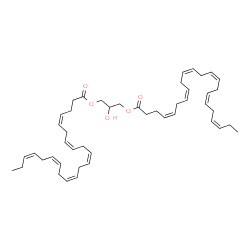124538-05-2
| Name | Didocosahexaenoin |
|---|---|
| Synonyms |
didocosahexaenoin
2-Hydroxy-1,3-propanediyl (4Z,7Z,10Z,13Z,16Z,19Z,4'Z,7'Z,10'Z,13'Z,16'Z,19'Z)bis(-4,7,10,13,16,19-docosahexaenoate) 1,3-Didocosahexaenoyl Glycerol 4,7,10,13,16,19-Docosahexaenoic acid, 2-hydroxy-1,3-propanediyl ester, (4Z,7Z,10Z,13Z,16Z,19Z,4'Z,7'Z,10'Z,13'Z,16'Z,19'Z)- |
| Description | Didocosahexaenoin, an omega-3 derivative, is a diglyceride of DHA and can be synthesised from DHA triglycerides. Didocosahexaenoin causes significant loss of mitochondrial membrane potential and induces ROS production. Didocosahexaenoin induces stronger cytotoxicity than DHA in human prostate carcinoma cells[1]. |
|---|---|
| Related Catalog | |
| In Vitro | 二十二碳六烯酸甘油二酯 (10-50 μM; 96 小时) 诱导 PC3 细胞凋亡[1]。 二十二碳六烯酸甘油二酯 (1 nM-100 μM; 96 小时) 对人前列腺细胞诱导剂量依赖性细胞毒性[1]。 二十二碳六烯酸甘油二酯 (30, 50 μM; 24 小时) 导致线粒体膜电位损失显着增加[1]。 Apoptosis Analysis[1] Cell Line: PC3 cells Concentration: 10, 20, 30, 40, 50 μM Incubation Time: 24, 48 hours Result: Caused elevated levels of early apoptotic cells. Significantly increased the level of activated caspase 3/7 for 6 h at 30 and 50 μM. Cell Cytotoxicity Assay[1] Cell Line: PC3, DU145, A2780 and A2780-CP70 carcinoma cells and MCF-7 and LNCaP cells Concentration: 1 nM–100 μM Incubation Time: 96 hours Result: Induced dose-dependent cytotoxicity with the strongest toxicity under 10.0 μM on DU145 and PC3 cells, A2780 and A2780-CP70 with IC50s of 3.20 and 3.82 μM, 4.6, 5.53 μM, respectively. |
| References |
| Density | 1.0±0.1 g/cm3 |
|---|---|
| Boiling Point | 748.5±60.0 °C at 760 mmHg |
| Molecular Formula | C47H68O5 |
| Molecular Weight | 713.040 |
| Flash Point | 204.8±26.4 °C |
| Exact Mass | 712.506653 |
| LogP | 13.59 |
| Vapour Pressure | 0.0±5.7 mmHg at 25°C |
| Index of Refraction | 1.528 |
